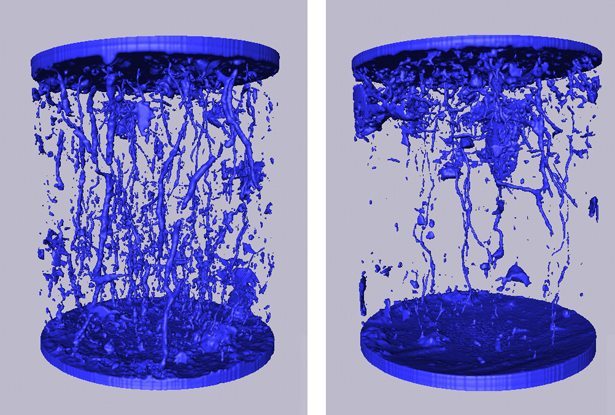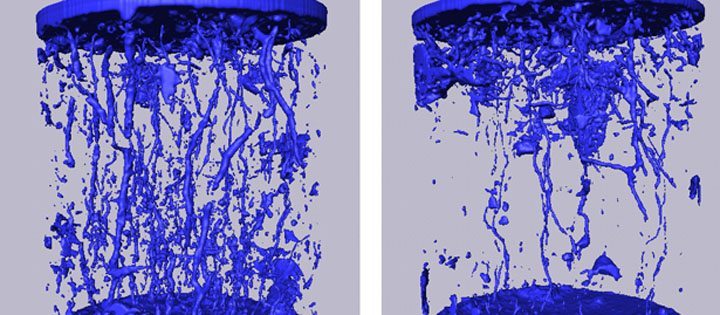The penetrometer has been the primary instrument for measuring soil compaction since its introduction in 1905.
More recently, Scandinavian soil scientists have used hospital CT scans for a more accurate measurement to clearly depict and quantify soil structures.
One of the pioneers in this area is Dorthe Wildenschild, a researcher in Oregon State University’s chemical, biological and environmental engineering department.
“When we started this work in Denmark, we actually took our core samples to a hospital in the nearby town and used their medical scanner to make images of the pores in the soil cores,” Wildenschild said.
Read Also

Volatile temperatures expected for this winter
DTN is forecasting a lot of temperature variability in the Canadian Prairies this winter. Precipitation should be close to average.
“But no, I’m not a soil scientist. I got involved because of my experience with imaging. It’s the same type of equipment as used in medical facilities.”
She said her role is to create images that clearly depict the pores and passages within the soil structure so that they can be measured and documented.
The project no longer uses hospital equipment, she added.
“That’s because a medical scanner can only give you about 500 to 600 microns resolution. I need five microns resolution in my work.”
The soil cores come from Denmark, Sweden, Norway and Finland.
Wildenschild was born and educated in Denmark but has been with OSU since 2002, currently using synchrotron radiation in her groundwater research.
When she has soil imaging challenges that she can’t solve with OSU instrumentation, she brings her work to a more powerful set of imaging tools in Chicago.
It’s interesting that the initial X-ray imaging of soil cores was done with equipment intended for human use because the large, air-filled macropores in untilled soil often resemble the branching vessels of the human circulatory system, according to the November/December 2013 issue of the Soil Science Society of America Journal.
The Nordic scientists found that heavy clay subsoil has long vertical arterial pores, which serve as pipes to let water move down into the soil. The heavy clay subsoil in non-compacted samples also has smaller horizontal pores branching out laterally to bring water to plant roots.
It was a different story for the compacted soil. The CT scan showed that the compacted soil contained mainly long, vertical arterial pores with significantly fewer lateral pores branching from them to bring water to crop roots. The core samples for these particular studies were pulled from Finland.
“Compaction also reduces the size of the vertical arteries,” according to a news release from the Soil Science Society of America.
“Just as in the human body, this constriction of the soil’s circulatory system can have ill effects. Blocked and narrowed pores likely impede the diffusion of air through bulk soil. The dominance of vertical pipes in the compacted soil also suggests that water flows mostly downward, with relatively little reaching the surrounding soil matrix.”
The research is significant because these compacted soil cores had neither a long history of compaction nor the high degree of compaction seen in headland soil on the Prairies. It was actually quite the opposite, according to the society.
“These changes can reduce crop productivity,” it said.
“Most troubling was how lasting the impacts of compaction appear to be. The group examined soil cores taken from a depth of .3 to .4 meters in plots where 30 years earlier a heavy tractor-trailer drove over the ground four times in an experimental treatment. Untrafficked control plots were used as a reference.
“Despite all the elapsed time, macropores in the compacted subsoil were still highly altered compared with control soils, indicating a poor ability of this heavy clay soil to recover its original structure. What’s more, the damage was done by wheel loads that were considerably lower than those used in agriculture today.”
Gas diffusion and air permeability were measured when the Finnish soil cores were drained, and the air-filled pore space was measured with an air pycnometer. The compaction treatment had significantly lowered the volume fraction of air-filled macropores.
The compacted soil displayed significantly lower air permeability, while gas diffusivity was not affected.
The conclusion was that this was because of a compaction-induced reduction in the cross-sectional area of vertical arterial macropores and in the volume of marginal pores branching from these vertical pores.
The scientists said subsoil compaction may be easy to ignore because it’s hard to see, but it definitely deserves more study, perhaps with better scientific instrumentation.

ron.lyseng@producer.com
















